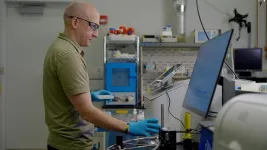(Press-News.org) American Geophysical Union
Press Release 24-27
For Immediate Release
25 June 2024
This press release is available online at: https://news.agu.org/press-release/worlds-lakes-less-resilient-climate-pollution/
AGU press contact:
Rebecca Dzombak, news@agu.org (UTC-4 hours)
Contact information for the researchers:
Ke Zhang, Chinese Academy of Sciences, kzhang@niglas.ac.cn (UTC+8 hours)
WASHINGTON — Nearly half of the world’s large lakes have lost resilience, or the ability to bounce back after an abrupt disturbance, in recent decades, according to the first global assessment of long-term changes in lake resilience. Lakes in eastern North America and northern Europe have been hit the hardest, and dense populations and pollution are largely to blame, the study suggests. However, wealthier regions had healthier lakes, suggesting costly conservation efforts may pay off.
Both people and climate can gradually shift lakes away from their natural, healthy state. Warmer temperatures can increase evaporation, decreased precipitation can lower lake levels, and persistent pollution can chip away at the lake ecosystem’s health. When sudden disturbances hit, such as heat waves, droughts or floods, a “resilient” lake can recover; a vulnerable one may not be able to return to its previous state.
Assessing a lake’s resilience, which takes into account its structure and ecosystem functions, is crucial for scientists predicting how it will respond to climate- and human-induced changes. But long-term trends of changes in lake resilience at a global scale — and why they happen — remain unknown. The new study, published in Geophysical Research Letters, fills in this knowledge gap.
“Tracking lake resilience is crucial because it allows us to detect early warning signs of ecosystem degradation,” said Ke Zhang, an environmental scientist at the State Key Laboratory of Lake Science and Environment at the Chinese Academy of Sciences who led the study. “It enables us to do timely interventions and prevent the irreversible catastrophic collapse of lake ecosystems, which can have severe socioecological consequences.”
Tracking lakes from space
Zhang and colleagues looked at comprehensive lake health and resilience and a mix of climate and human factors for 1,049 of the world’s largest and most important lakes, looking for changes from 2000 to 2018. A suite of statistical tests allowed the scientists to look for “flickers” and longer-term changes in a lake’s color, indicating changes in its health. If at least two of the statistical tests agreed, the researchers marked the lake as experiencing a change in resilience. The researchers analyzed lake area, depth and satellite-derived color in the context of each catchment’s temperature, precipitation, population density, and per capita gross domestic product (GDP).
Nearly half of the studied lakes worldwide significantly lost resilience over the study period, the researchers found. Most were between 30-60 degrees N, but the authors note that many of the world’s lakes are in the higher latitudes of the northern hemisphere, with more growing there under climate change.
On the other hand, about one quarter of studied lakes were getting more resilient — mostly at higher altitudes, and mostly because of an increase in glacial meltwater. The Tibetan Plateau and the Andes had the strongest gains in resilience as a result of glacial melt. Central North America, mostly in Canada, also saw an increase in lake resilience.
The researchers then divided the study period in half to see if any trends accelerated in recent years. From 2000 to 2009, roughly the same proportion of lakes experienced increasing and decreasing resilience, at 36% and 35%, respectively. But between 2010 to 2018, while 28% of lakes gained resilience, 39% lost resilience, indicating a pronounced shift in lake health. In recent years, 26.8% of lakes went from becoming more resilient to becoming less resilient between the two time periods. This pattern was particularly strong in eastern North America and northern Europe.
The results took the researchers by surprise.
“While we anticipated that human activities would significantly impact lake resilience, the extent of resilience decline — nearly half of the studied lakes — was alarming,” Zhang said. The findings could indicate many lakes are approaching irreversible ecological tipping points, the authors wrote.
What’s messing up our lakes?
Population density most strongly contributed to lakes’ loss of resilience, the study found, most likely linked to having higher concentrations of pollutants and higher degrees of landscape alteration.
Bigger lakes and lakes at higher elevations were more likely to be more resilient.
In most regions, human factors were more important than climate, but high-altitude regions such as the Tibetan Plateau were the clear exception. There, warmer air temperatures lead to glacial melting, which in turn allows lakes to grow larger and clearer. And in tropical and subtropical regions, climate matters because warmer temperatures increase the risk of algae blooms, which degrade water quality and lake health. However, each of these is only an association in this study and requires further research for validation, the authors say.
There is some good news. Many lakes in regions with higher GDPs are improving, which the authors posit is tied to efforts such as reforestation, sustainable land use and combating eutrophication. The pattern of more resilient lakes in high-GDP catchments suggests continued efforts focused on lake health could help, according to the authors.
“This trend is concerning and underscores the urgent need for effective management and restoration efforts to mitigate these impacts,” Zhang said. “But the positive correlation between higher GDP and increased resilience in some areas implies that economic development can be harnessed to invest in environmental protection and lake management.”
#
Notes for journalists:
This study was published in Geophysical Research Letters, an open-access AGU journal. Neither this press release nor the study is under embargo. View and download a pdf of the study here.
Paper title:
“Human impacts dominate global loss of lake ecosystem resilience”
Authors:
Ke Zhang (corresponding author), Qi Lin, Key Laboratory of Lake and Watershed Science for Water Security, Nanking Institute of Geography and Limnology, Chinese Academy of Sciences, Nanjing, China
Yaoyao Han, Key Laboratory of Lake and Watershed Science for Water Security, Nanking Institute of Geography and Limnology, Chinese Academy of Sciences, Nanjing, China; University of Chinese Academy of Sciences, Beijing, China
Chenliang Du, Ji Shen, School of Geography and Ocean Science, Nanjing University, Nanjing, China
#
AGU (www.agu.org) is a global community supporting more than half a million advocates and professionals in Earth and space sciences. Through broad and inclusive partnerships, AGU aims to advance discovery and solution science that accelerate knowledge and create solutions that are ethical, unbiased and respectful of communities and their values. Our programs include serving as a scholarly publisher, convening virtual and in-person events and providing career support. We live our values in everything we do, such as our net zero energy renovated building in Washington, D.C. and our Ethics and Equity Center, which fosters a diverse and inclusive geoscience community to ensure responsible conduct.
END
Half of world’s lakes are less resilient to disturbance than they used to be
Some high-altitude lakes are more resilient, or able to bounce back to a baseline state, after a disturbance because increased glacial melt is temporarily feeding them
2024-06-25
ELSE PRESS RELEASES FROM THIS DATE:
International trial introduces another curative option for sickle cell disease
2024-06-25
Vanderbilt University Medical Center (VUMC) researchers are touting data from a multicenter, international phase 2 clinical trial showing a new, curative treatment for sickle cell disease (SCD).
The therapy, nonmyeloablative haploidentical bone marrow transplant (BMT) with thiotepa and posttransplant cyclophosphamide (PTCy), is proving to have equivalent efficacy and one-fifth the cost as recently FDA-approved myeloablative gene therapy options, according to Michael DeBaun, MD, MPH, director of the Vanderbilt-Meharry Center ...
Study reveals potential therapeutic role of sodium valerate in reducing binge drinking
2024-06-25
In a significant finding, researchers from The Jackson Laboratory (JAX) and UConn Health have discovered that sodium valerate, a short-chain fatty acid produced by gut microbes, can dramatically reduce binge drinking behavior and blood ethanol concentration in mice. The study, reported June 17 in Microbiome, offers promising insights into the gut-brain axis and presents a novel therapeutic approach for excessive alcohol use.
We are interested in physiological addiction genetics and genomics to identify new drug targets for treating addiction/overdose.
The research team, led by Yanjiao Zhou, M.D., ...
Your future medications could be personalized for you on a 3D printer
2024-06-25
Chocolate-flavored pills for children who hate taking medicine.
Several drugs combined into one daily pill for seniors who have trouble remembering to take their medications.
Drugs printed at your local pharmacy at personalized dosages that best suit your health needs.
These are just a few potential advantages of 3D drug printing, a new system for manufacturing drugs and treatments on-site at pharmacies, health care facilities and other remote locations.
In 2015, the Food and Drug Administration approved the first 3D-printed drug, Spritam ...
Study finds foreign-born CEOs likelier to acquire international targets, including in their birth country
2024-06-25
Toronto - New research shows that CEOs who have moved away from their country of origin have a significantly higher tendency to make acquisitions internationally, with a preference for targets in their birth country or in countries that once colonized it.
“Foreign-born CEOs are taking an increasing leadership role in the corporate world,” says researcher Ron Shalev, an associate professor of accounting at the University of Toronto Scarborough who is cross-appointed to U of T’s Rotman School of Management. “In our sample, 24 per ...
For better loan terms, find a partner
2024-06-25
Shoppers browsing through blouses and blenders at Target know they can also quaff a cappuccino at one of more than 1,700 Starbucks cafeshoused within Targets. The strategic alliance benefits both corporations by helping them reach new markets, boost their brands, and add incremental sales.
Collaborative partnerships such as this have grown at a pace of 3,600 per year, according to the SDC Platinum database. That’s partly because companies in alliances can gain access to new technologies and customers while keeping their autonomy.
New research from Texas McCombs highlights ...
How uncertainty builds anxiety
2024-06-25
Alfred Hitchcock observed that “There is no terror in the bang, only in the anticipation of it.” A common way to build suspense in a movie scene is for the audience to know something bad is going to happen, but not when it is going to happen. But how does uncertainty work to ratchet up our anxiety? In a recent paper in the journal Computational Psychiatry, researchers at the University of California, Davis, Department of Psychology take a deeper look into what builds fear.
Not knowing when something will happen can cause anxiety, but until ...
Adolescents today are more satisfied with being single
2024-06-25
Young people aged 14 to 20 years are nowadays more satisfied with being single than their counterparts ten years ago. This is the conclusion of a study undertaken by the Institute of Psychology at Johannes Gutenberg University Mainz (JGU). "It seems that today's adolescents are less inclined to pursue a romantic relationship. This could well be the reason for the increased singlehood satisfaction," said psychologist Dr. Tita Gonzalez Avilés, lead author of the recent study. Growing numbers of people are living as ...
Researchers discover new flat electronic bands, paving way for advanced quantum materials
2024-06-25
In a study published in Nature Communications June 19, a team of scientists led by Rice University’s Qimiao Si predicts the existence of flat electronic bands at the Fermi level, a finding that could enable new forms of quantum computing and electronic devices.
Quantum materials are governed by the rules of quantum mechanics, where electrons occupy unique energy states. These states form a ladder with the highest rung called the Fermi energy.
Electrons, being charged, repel each other and move in correlated ways. ...
Discovery of vast sex differences in cellular activity has major implications for disease treatment
2024-06-25
By Darrin S. Joy
“We discovered a pronounced ‘men are from Mars, women are from Venus’ pattern,” says marine and environmental biologist Suzanne Edmands.
She refers not to human psychology, but rather to mitochondria, the cell components responsible for generating energy.
Edmands, professor of biological sciences at the USC Dornsife College of Letter, Arts and Sciences, recently published research in the Proceedings of the National Academy of Sciences that reveals vast differences in gene activity within the mitochondria of males compared to females.
Although the study looks at tiny marine organisms called copepods, ...
nTIDE June 2024 Deeper Dive: Employment trends for people with disabilities highlight continued gains for those with vision impairments
2024-06-25
East Hanover, NJ – June 25, 2024 – The employment-to-population ratio for individuals with vision impairments continues to show marked improvement, according to data shared during the according to last Friday’s National Trends in Disability Employment (nTIDE) Deeper Dive Lunch & Learn Webinar. nTIDE is a joint effort by Kessler Foundation and the University of New Hampshire’s Institute on Disability (UNH-IOD).
Director of Research Arielle Silverman, PhD, and Research Specialist Sarahelizabeth Baghun, PhD, from the ...
LAST 30 PRESS RELEASES:
Researchers find promising new way to boost the immune response to cancer
Coffee as a staining agent substitute in electron microscopy
Revealing the diversity of olfactory receptors in hagfish and its implications for early vertebrate evolution
Development of an ultrasonic sensor capable of cuffless, non-invasive blood pressure measurement
Longer treatment with medications for opioid use disorder is associated with greater probability of survival
Strategy over morality can help conservation campaigns reduce ivory demand, research shows
Rising temperatures reshape microbial carbon cycling during animal carcass decomposition in water
Achieving ultra-low-power explosive jumps via locust bio-hybrid muscle actuators
Plant-derived phenolic acids revive the power of tetracycline against drug-resistant bacteria
Cooperation: A costly affair in bacterial social behaviour?
Viruses in wastewater: Silent drivers of pollution removal and antibiotic resistance
Sub-iethal water disinfection may accelerate the spread of antibiotic resistance
Three in four new Australian moms struggle with body image
Post-stroke injection protects the brain in preclinical study
Cardiovascular risk score predicts multiple eye diseases
Health: estimated one in ten British adults used or interested in GLP-1 medications for weight loss
Exercise to treat depression yields similar results to therapy
Whooping cough vaccination for pregnant women strengthens babies’ immune system
Dramatic decline in new cases of orphanhood in Uganda driven by HIV treatment and prevention programs
Stopping weight loss drugs linked to weight regain and reversal of heart health markers
Higher intake of food preservatives linked to increased cancer risk
Mass General Brigham–developed cholera vaccine completes phase 1 trial
First experimental validation of a “150-year-old chemical common sense” direct visualization of the molecular structural changes in the ultrafast anthracene [4+4] photocycloaddition reaction
Lack of support for people on weight loss drugs leaves them vulnerable to nutritional deficiencies, say experts
Dogs’ dinners can have greater climate impact than owners’
Are you ready to swap salmon for sprats and sardines?
1.6 million UK adults used weight loss drugs in past year
American College of Cardiology comments on new dietary guidelines for Americans
American Society of Gene & Cell Therapy and Orphan Therapeutics Accelerator partner to advance and commercialize promising rare disease treatments
One in 14 patients having day case surgery have new or worse chronic pain 3 months after their operation
[Press-News.org] Half of world’s lakes are less resilient to disturbance than they used to beSome high-altitude lakes are more resilient, or able to bounce back to a baseline state, after a disturbance because increased glacial melt is temporarily feeding them





